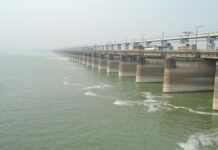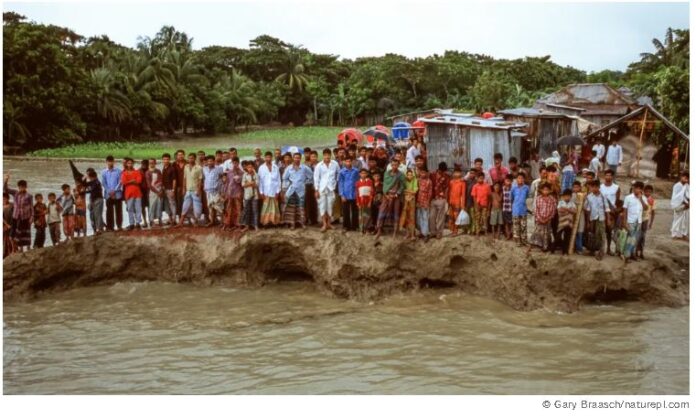By Roton Malo
A photograph of climate victim villagers in Bhola Island, grabbed attention of climate activists recently which was selected in the top ten most influential pictures depicting the climate change impacts across the world.
Gary Braasch of naturepl.com captured the photo in 2005, where villagers are seen standing on a remnant of a road in Bhola. The people there at the mouth of the Ganges delta, is still suffering from accelerated erosion due to sea level rise. CNN on March 30, 2023, published the most ten climate change focusing photos in the Call To Earth category.
According to a World Bank report, Bangladesh ranks as the 7th most vulnerable country to climate change. The average tropical cyclones cost Bangladesh about $1 billion annually.
The report in 2022 says that by 2050, one-third of agricultural GDP may be lost due to climate variability and extreme events – a devastating figure as the agriculture sector represents around half of employment in the country.
Altogether 13.3 million people may become internal migrants in next 30 years due to climate impacts on agriculture, water scarcity, and rising sea levels, with higher impacts on women, says the World Bank report.
The other photos show the impacts of climate change across the world…. 
Waterfalls pour off a Nordaustlandet ice cap in Svalbard, Norway, during an unusually warm summer in 2014. -Photo by Paul Nicklen.
An emaciated polar bear staggers on the search for food. The photograph, taken in 2017, received widespread attention, sparking a conversation around climate change. -Photo by Cristina Mittermeier
A kangaroo jumps past a burning house in Lake Conjola, Australia in December 2019. That season’s bushfires were among the worst the country had ever seen, with nearly three billion animals killed or displaced. -Photo by Matthew Abbott/The New York Times
The bodies of six giraffes lie on the outskirts of Eyrib village in Sabuli wildlife conservancy, Kenya, in 2021. A prolonged drought in the northeast of the country and the wider Horn of Africa has created food and water shortages for both animals and local communities. -Photo by Ed Ram/Getty Images
These photos, taken in 2007 and 2022, show the retreating Sólheimajökull glacier in Iceland. In the last two decades, the speed of glacier melt is estimated to have doubled due to global warming. -Photo by James Balog/Earth Vision Institute.
Polar bears move into an abandoned weather station in Kolyuchin, Russia. The majestic mammals are at particular risk from climate change, which is melting the Arctic sea ice that they depend on. -Photo by Dmitry Kokh
Alice, Stanley and their child were displaced as floods destroyed their house in Kenya in 2017. They are photographed at the Ol Pejeta Conservancy together in the same frame as Najin, one of the last two northern white rhinos in the world. It’s part of photographer Nick Brandt’s “The Day May Break” series that portrays people and animals impacted by environmental destruction. -Photo by Nick Brandt of Fahey/Klein Gallery, Los Angeles
A school of bright cardinalfish swerve to make way for a sea lion in the Galápagos. The archipelago off the coast of Ecuador is famous for its vibrant marine life and is one of the largest marine protected areas in the world. -Photo by Cristina Mittermeier
Bowhead whales, like this one photographed near Baffin Island in Canada, can live to more than 200 years old. Some may have witnessed first-hand the effects of climate change since the Industrial Revolution. -Photo by Paul Nicklen
- Call to Earth is a CNN editorial series that publishes reports on environmental challenges facing the planet.
































